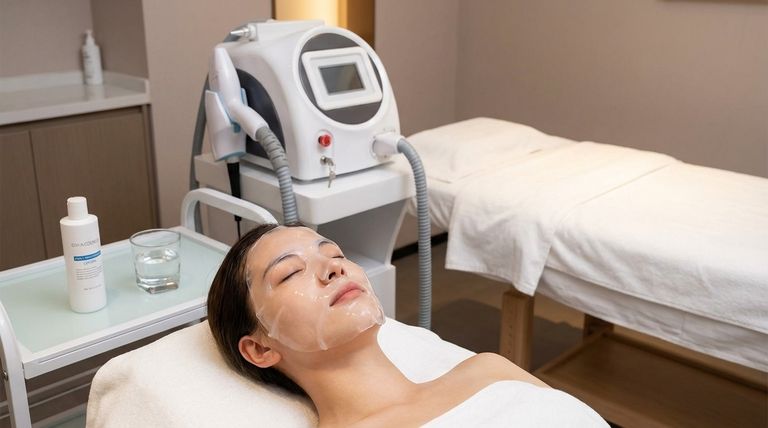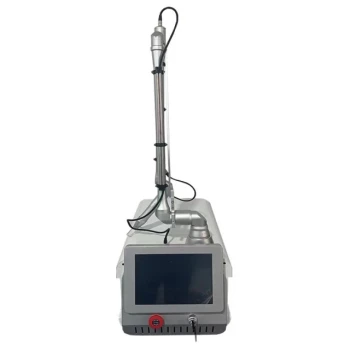For most Nd:YAG laser treatments, the recovery period is exceptionally short, with minor side effects like redness and slight swelling typically resolving within a few hours to two days. However, when the laser is used for more intensive procedures like aggressive skin resurfacing, the downtime is longer, and you should plan for a recovery period of approximately one week.
The single most important factor determining your Nd:YAG laser recovery time is the intensity and purpose of the treatment. While many procedures have virtually no downtime, more aggressive applications require a longer healing process to achieve more significant results.

What Determines Your Recovery Timeline?
The term "Nd:YAG laser treatment" covers a wide range of procedures with vastly different levels of intensity. Understanding which type of treatment you are receiving is the key to predicting your recovery experience.
The Role of Treatment Intensity
A gentle laser facial or "toning" procedure uses low energy to stimulate collagen with minimal disruption to the skin's surface. This is often called a "lunchtime" treatment because side effects are minor and fade within hours.
In contrast, an ablative or semi-ablative resurfacing procedure uses much higher energy to remove microscopic layers of skin. This controlled injury triggers a more robust healing response, which requires a longer recovery period.
The Specific Condition Being Treated
Treating isolated pigmented spots or performing hair removal will result in localized redness that subsides quickly. A full-face treatment for texture, wrinkles, or acne scars is a more involved process and will naturally involve a longer and more widespread recovery.
What to Expect During Recovery: A Timeline
Your post-treatment experience will fall into one of two general paths, depending entirely on the energy level used during your procedure.
Immediately After Treatment (First Few Hours)
For nearly all Nd:YAG treatments, you can expect some degree of redness and a warm sensation, similar to a mild sunburn. Slight swelling in the treated area is also common. These effects are most noticeable right after your session.
The First 24-48 Hours (For Standard Treatments)
For most non-ablative procedures, the initial redness and swelling will almost completely resolve within this timeframe. Your skin may feel slightly sensitive, but you can typically resume normal activities and apply makeup.
Day 3 to Day 7 (For Intensive Treatments)
This timeline applies to more aggressive resurfacing. During this period, your skin will be actively healing. You may experience continued redness, dryness, and peeling or flaking. For the most intensive treatments, light crusting can occur as the new skin regenerates underneath.
Understanding the Trade-offs
Choosing the right laser treatment involves balancing your desired outcome with the amount of downtime you can tolerate. Acknowledging the risks and your role in the healing process is crucial.
The Downtime vs. Results Spectrum
There is a direct correlation between downtime and the degree of improvement you can expect. A no-downtime laser facial will provide a subtle glow and collagen boost, while a one-week recovery treatment can produce a dramatic reduction in wrinkles and textural irregularities.
The Critical Importance of Aftercare
Your recovery speed and final results are heavily dependent on your adherence to aftercare instructions. Failing to protect your healing skin from the sun can lead to hyperpigmentation and negate the benefits of the treatment.
Following your practitioner's guidance on cleansing, moisturizing, and sun protection is not optional—it is an essential part of the procedure itself.
Making the Right Choice for Your Goal
Align your expectations with the treatment's intensity and its corresponding recovery period.
- If your primary focus is a quick refresh with no downtime: A gentle laser toning session is your best option, with recovery limited to a few hours of mild redness.
- If your primary focus is treating specific spots or unwanted hair: Expect localized redness and sensitivity that typically resolves completely within one to two days.
- If your primary focus is significant skin resurfacing for texture or wrinkles: You must plan for a dedicated recovery period of about one week to allow your skin to heal properly.
Ultimately, understanding that recovery time is a direct function of treatment intensity allows you to plan effectively and achieve your desired results safely.
Summary Table:
| Treatment Intensity | Typical Recovery Timeline | Key Side Effects |
|---|---|---|
| Gentle / Toning | Few hours to 1 day | Mild redness, slight warmth |
| Standard (e.g., Hair Removal) | 1 to 2 days | Localized redness, sensitivity |
| Intensive Resurfacing | 3 days to 1 week | Redness, swelling, peeling, flaking |
Ready to offer advanced, predictable treatments to your clients? The right equipment is key to managing downtime and achieving superior results. BELIS specializes in professional medical aesthetic equipment, providing reliable Nd:YAG lasers and comprehensive support to medical aesthetics clinics and premium beauty salons. Let us help you enhance your service offerings and client satisfaction. Contact our experts today for a personalized consultation.
Visual Guide

Related Products
- Q Switch Nd Yag Laser Machine Tattoo Removal Nd Yag Machine
- Pico Picosecond Laser Machine for Tattoo Removal Picosure Pico Laser
- Clinic Use IPL and SHR Hair Removal Machine with Nd Yag Laser Tattoo Removal
- Diode Laser SHR Trilaser Hair Removal Machine for Clinic Use
- Trilaser Diode Hair Removal Machine for Beauty Clinic Use
People Also Ask
- Is Q-Switch laser safe for skin? Achieve Precise, Non-Invasive Skin Rejuvenation Safely
- What is the mechanism of action of the YAG laser? Precision Cutting & Deep Tissue Coagulation
- How much does a laser tattoo removal machine cost? Choose the Right Tech for Your Clinic
- How does the Nd:YAG laser work? Unlocking Deep-Tissue Precision for Medical Aesthetics
- Is Q Switched Nd:YAG laser good? The Gold Standard for Tattoo & Pigment Removal



















